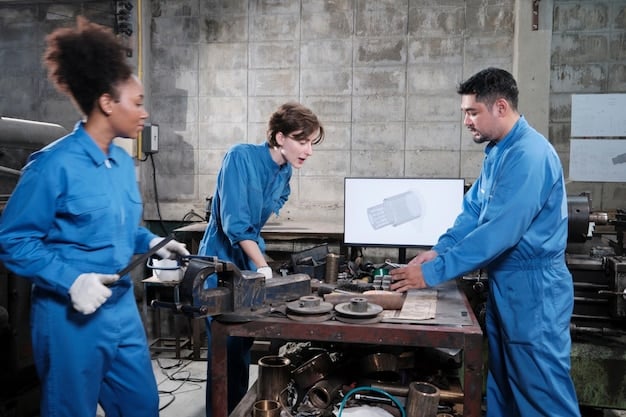The Future of Vocational Training: Preparing Students for Skilled Trades

The future of vocational training focuses on adapting curricula to meet the evolving demands of skilled trades, incorporating technology and hands-on experience to prepare students for successful careers.
The landscape of education is undergoing a significant transformation, particularly in how schools are preparing students for the demands of skilled trades. The future of vocational training: How schools are preparing students for skilled trades involves innovative approaches that blend traditional craftsmanship with cutting-edge technology, ensuring graduates are ready to tackle the challenges and opportunities of the modern workforce.
The Evolving Role of Vocational Education
Vocational education is no longer viewed as a secondary option but as a crucial pathway to address the growing skills gap in various industries. As technology advances and the demands of the workforce change, vocational training programs are adapting to equip students with the expertise and practical skills needed to thrive.
Changing Perceptions of Skilled Trades
For many years, vocational careers were often overlooked in favor of traditional four-year college degrees. However, there’s been a significant shift in perception as the demand for skilled workers rises and the value of hands-on training becomes more apparent. Parents and students alike are now recognizing the potential for stable, well-paying careers in trades such as construction, manufacturing, and technology.
Integrating Technology into Training
One of the key changes in vocational education is the integration of technology into the curriculum. From computer-aided design (CAD) to robotics and automation, students are learning how to use the latest tools and software that are essential in modern workplaces. This technological integration not only enhances their skills but also makes vocational careers more appealing to a tech-savvy generation.
- Virtual Reality (VR) Training: VR simulations offer immersive, risk-free environments for students to practice complex tasks and procedures.
- Online Learning Platforms: Online resources and platforms provide students with access to a wide range of courses, tutorials, and learning materials.
- Data Analytics: Understanding data analytics helps students optimize processes, improve efficiency, and make data-driven decisions in their respective fields.
In conclusion, vocational education is evolving to meet the demands of a rapidly changing workforce by incorporating technology and adapting to shifting perceptions of skilled trades.
Curriculum Innovations in Vocational Programs
Curriculum innovations are at the forefront of the transformation in vocational training, ensuring that programs remain relevant and effective. These innovations include a focus on hands-on learning, industry partnerships, and personalized learning experiences tailored to individual student needs.

Hands-On Learning Approaches
Hands-on learning is a cornerstone of effective vocational training. By engaging in practical, real-world projects, students develop a deeper understanding of the concepts and skills they are learning. This approach not only enhances their technical abilities but also fosters problem-solving skills and critical thinking.
Industry Partnerships and Apprenticeships
Collaborations between schools and industry partners are becoming more common, providing students with valuable apprenticeship opportunities and real-world experience. These partnerships allow students to work alongside professionals, gain insights into industry practices, and build valuable networks that can help them secure employment after graduation.
- Internships: Structured internship programs provide students with supervised work experience in their field of study.
- Mentorship Programs: Pairing students with experienced professionals offers guidance, support, and career advice.
- Industry-Sponsored Projects: Companies sponsor projects that allow students to tackle real-world challenges and develop innovative solutions.
In summary, curriculum innovations in vocational programs are enhancing the learning experience by focusing on hands-on approaches, industry partnerships, and personalized education pathways.
The Role of Technology in Modern Vocational Training
Technology plays a pivotal role in modern vocational training, enhancing the learning experience and preparing students for the digital demands of the workforce. From digital literacy to specialized software training, technology integration is essential for creating a skilled and adaptable workforce.
Digital Literacy and Essential Skills
Digital literacy is a fundamental skill for all modern workers, regardless of their field. Vocational training programs are increasingly incorporating digital literacy training to ensure students can effectively use computers, software, and online resources. This includes skills such as data analysis, digital communication, and cybersecurity awareness.
Simulations and Virtual Reality
Simulations and virtual reality (VR) technologies are revolutionizing vocational training by providing immersive, interactive learning experiences. VR simulations allow students to practice complex tasks and procedures in a safe, controlled environment. This is particularly valuable in high-risk fields such as construction, healthcare, and manufacturing.

- 3D Printing: 3D printing technology allows students to create prototypes, models, and custom parts, enhancing their design and manufacturing skills.
- Robotics and Automation: Training in robotics and automation systems prepares students for careers in advanced manufacturing and engineering.
- Data Visualization: Learning to visualize and interpret data helps students identify trends, solve problems, and make informed decisions.
In synthesis, technology is integral to modern vocational training, providing students with essential digital literacy, immersive simulations, and specialized software skills for success in today’s digital economy.
Addressing the Skills Gap with Targeted Programs
Targeted programs are designed to address the growing skills gap in various industries by providing specialized training and education in high-demand fields. These programs often focus on emerging technologies and industries, ensuring that students are well-prepared for the job market.
Identifying High-Demand Industries
One of the key steps in addressing the skills gap is to identify the industries and occupations that are experiencing the greatest demand for skilled workers. This requires ongoing research and collaboration with industry partners to understand their current and future workforce needs. High-demand industries often include healthcare, technology, renewable energy, and advanced manufacturing.
Creating Specialized Training Programs
Once high-demand industries have been identified, specialized training programs can be developed to equip students with the specific skills and knowledge needed to succeed in those fields. These programs often include a combination of classroom instruction, hands-on training, and real-world experience through internships and apprenticeships.
- Cybersecurity Training: Cybersecurity programs address the growing need for professionals to protect digital assets and infrastructure.
- Healthcare Technology: Training in healthcare technology prepares students for careers in medical informatics, health data analytics, and biomedical engineering.
- Renewable Energy: Programs in renewable energy focus on solar, wind, and other sustainable energy technologies, preparing students for careers in the green economy.
In short, addressing the skills gap requires identifying high-demand industries and developing specialized training programs that equip students with the skills and knowledge needed to succeed.
The Importance of Soft Skills in Vocational Success
While technical skills are essential for vocational success, soft skills such as communication, teamwork, and problem-solving are equally important. Vocational training programs are increasingly focusing on developing these soft skills to ensure that graduates are well-rounded and prepared for the demands of the modern workplace.
Communication and Collaboration
Effective communication and collaboration are essential for working in teams and interacting with clients and colleagues. Vocational training programs are incorporating activities and assignments that require students to communicate effectively, listen actively, and work collaboratively to achieve common goals. This includes both verbal and written communication skills, as well as the ability to adapt communication styles to different audiences.
Problem-Solving and Critical Thinking
Problem-solving and critical thinking skills are essential for addressing complex challenges and finding innovative solutions. Vocational training programs are encouraging students to think critically, analyze information, and develop creative solutions to real-world problems. This includes hands-on projects, case studies, and simulations that require students to apply their knowledge and skills to solve complex issues.
- Time Management: Learning to manage time effectively helps students prioritize tasks, meet deadlines, and balance multiple responsibilities.
- Leadership Skills: Developing leadership skills prepares students to take on leadership roles, motivate teams, and drive innovation.
- Adaptability: Being adaptable and flexible allows students to adjust to changing circumstances, learn new skills, and embrace new technologies.
In summary, the importance of soft skills in vocational success cannot be overstated. Communication, teamwork, problem-solving, and critical thinking are all essential for thriving in the modern workplace and achieving long-term career success.
Future Trends in Vocational Training: What to Expect
The future of vocational training is shaped by emerging trends and technologies that are transforming the way students learn and prepare for their careers. These trends include personalized learning, micro-credentials, and a greater emphasis on lifelong learning and continuous professional development.
Personalized Learning and Adaptive Technologies
Personalized learning approaches tailor instruction to meet the individual needs and learning styles of each student. Adaptive technologies use data analytics and artificial intelligence to provide students with customized learning paths, feedback, and support. These technologies continuously assess student progress and adjust the curriculum to ensure that students master the material at their own pace.
Micro-Credentials and Stackable Certifications
Micro-credentials and stackable certifications provide students with opportunities to earn recognition for specific skills and competencies. These credentials can be earned through short courses, workshops, and online modules, allowing students to build their skills incrementally and demonstrate their expertise to employers.
- Lifelong Learning: Encouraging lifelong learning helps students stay current with industry advancements, develop new skills, and adapt to changing job requirements.
- Emphasis on Innovation: Promoting innovation and creativity helps students develop new ideas, solve complex problems, and drive progress in their respective fields.
- Global Competencies: Developing global competencies prepares students to work in diverse cultural environments and collaborate with international teams.
In conclusion, the future of vocational training is characterized by personalized learning, micro-credentials, and a greater emphasis on lifelong learning and continuous professional development. These trends will help ensure that students are well-prepared for the challenges and opportunities of the future workforce.
| Key Point | Brief Description |
|---|---|
| 🛠️ Hands-On Learning | Practical projects enhance technical and problem-solving skills. |
| 💻 Technology Integration | VR, simulations, and digital literacy are essential. |
| 🤝 Industry Partnerships | Apprenticeships and internships provide real-world experience. |
| 🎯 Skills Gap Programs | Targeted training in high-demand industries like healthcare and tech. |
FAQ
▼
Vocational training is education that focuses on providing practical skills and knowledge for specific occupations or trades. It prepares students for direct entry into the workforce.
▼
Vocational training addresses the skills gap, equips individuals with in-demand skills, and provides a pathway to stable, well-paying careers in various industries.
▼
Technology is integrated through digital literacy training, VR simulations, 3D printing, robotics, and specialized software training to enhance learning.
▼
Micro-credentials and stackable certifications offer recognition for specific skills, allowing students to build expertise through short courses and demonstrate competence to employers.
▼
Essential soft skills include communication, teamwork, problem-solving, critical thinking, time management, leadership, and adaptability, ensuring well-rounded graduates.
Conclusion
In conclusion, the future of vocational training is evolving to meet the demands of the modern workforce by integrating technology, emphasizing hands-on learning, and addressing the skills gap with targeted programs. As perceptions of skilled trades shift and technology continues to advance, vocational education will play an increasingly important role in preparing students for successful and fulfilling careers.





